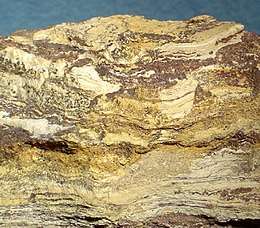Corderoite
Corderoite is an extremely rare mercury sulfide chloride mineral with formula Hg3S2Cl2. It crystallizes in the isometric crystal system. It is soft, 1.5 to 2 on the Mohs scale, and varies in color from light gray to black and rarely pink or yellow.
| Corderoite | |
|---|---|
 | |
| General | |
| Category | Halide mineral |
| Formula (repeating unit) | Hg3S2Cl2 |
| Strunz classification | 2.FC.15a |
| Crystal system | Cubic |
| Crystal class | Tetartoidal (23) (same H-M symbol) |
| Space group | I213 |
| Unit cell | a = 8.940(5) Å; Z = 4 |
| Identification | |
| Color | Pale orange-pink to salmon-pink; on exposure to light, rapidly darkening to pale gray, then black |
| Crystal habit | Rare as cubic crystals; as rims and replacements of cinnabar |
| Mohs scale hardness | 3 |
| Diaphaneity | Transparent |
| Specific gravity | 6.845 calc. |
| Optical properties | Isotropic |
| Refractive index | n > 2.5 |
| References | [1][2][3] |
It was first described in 1974 for occurrences in the McDermitt Mercury mine in Humboldt County, Nevada. The name is from the old name of the mine, the Old Cordero Mine.[4]
Structure
Corderoite has crankshaft chains that are crosswise linked by additional Hg²+. The bond distance between the cation Hg and anion S is 2.422 Angstroms. It has two angles, Hg-S-HG= 94.1º and S-Hg-S= 165.1º. Various sulfide halides of Hg share the feature of being face-sharing [HgS2X4] −6 polyhedral, as corderoite's polyhedra X=Cl.
Geologic occurrence
The main occurrence of corderoite in the type locality is in the Upper Miocene playa sediments within a thick zone, around 5–7 m (16–23 ft), sub parallel to bedding. Lake sediments including altered rhyolitic tuff and ash were deposited on the Tertiary rhyolitic volcanic rocks. Corderoite occurs as isolated grains or with cinnabar as replacements. Corderoite occurs as a low temperature supergene mineral.[5]
References
- http://rruff.geo.arizona.edu/doclib/hom/corderoite.pdf Handbook of Mineralogy
- http://www.mindat.org/min-1127.html Mindat with location data
- http://www.webmineral.com/data/Corderoite.shtml Webmineral data
- http://www.mindat.org/loc-4206.html Mindat McDermii Mine page
- Berendsen P., Foord E. E., and Storey L. O. (1974) "Corderoite, first natural occurrence of Hg3S2Cl2, from the Cordero mercury deposit, Humboldt County, Nevada". American Mineralogist, 59, 652–655 http://www.minsocam.org/ammin/AM59/AM59_652.pdf
- Grenchischev O. K. and Vasil'ev V. I. (1978) "First find of Corderoite (Hg3S2Cl2) in mercury ores of USSR". Doklady. 246/1-6, 145.
- Keller P., Lissner F., and Schleid T. (2005) "Single-crystal structure determination of Perroudite, Hg5Ag4S5 (I,Br)2Cl2, from Tsumeb (Namiba), and its structural relationships to other sulfide halides of mercury and cinnabar." Stuttgart 181/1, 1–9.
- Lavrent'ev Y. G. and Vasil'ev V. I. (1986) "New finds and data on the composition of corderoite (Hg3S2Cl2)". Soviet Geology and Geophysics, 27/12, 117–121.
- Modreski P. J. (1998) "Eugene Edward Foord, 1946–1998". The Canadian Mineralogist, 36/2, 251–254.